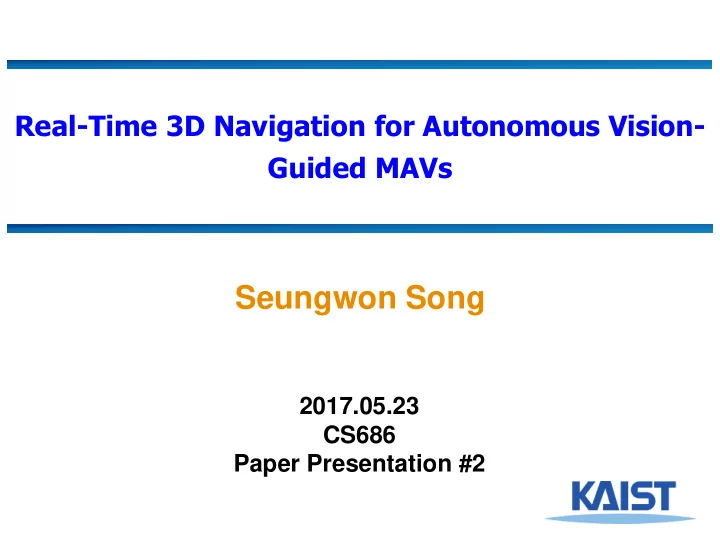

Real-Time 3D Navigation for Autonomous Vision- Guided MAVs Seungwon Song 2017.05.23 CS686 Paper Presentation #2
Suzi Kim’s Presentation Cell Decomposition Cell Visit - Shrink Using TSP - Split 2
Contents ● Introduction ● Conventional approach ● Basic concepts ● Detail of each concepts ● Result 3
Introduction ● Regular 3D state lattice requires a large amount of memory while graph search even though problem is easier to solve. ● Using Octree-based state lattice which represent discretizes large swathes of free space into few symbolic octants. ● Warning! ● It does not contain any Math, just in robotical perspective! ● So, just basic result comparison with conventional method. 4
Conventional Approach ● There are several grid-based path planning method in 2D. ● In 3D, there are too many points, so reduced them by using Octomap. ● Using reduced 3D grid, Researchers can use conventional A* or other algorithms Grid based pathplanning Octomap 5
Basic Concepts ● Simplify Quadrotor dynamic ● Reduce resolution of Octomap (octants) ● Octree-Based State Lattice Adjacency between octree node states ● Multi-resolution path lookup-table ● Pre-discretization ● ● Local 3D State Lattice ● Graph search Optimal path finding ● Path reconstruction ● 6
Octree-Based State Lattice ● Adjacency between octree node states To determine whether two octants are adjacent to each other. ● If distance between two cell’s center exceeds half of the sum of ● two octants’ cell size, two octants are not adjacent. Distance between two cell Is longer then the half of the sum of Octants! Neighbor Neighbor? 7
Octree-Based State Lattice ● Multi-resolution path lookup-table Computing path between every octants’ consume ● much computational cost. How about save all pre-computed cost and path ● in the table? They set 16 states in yaw angle (22.5 deg inc) ● They set lookup index ( θ 1 ,x 1 -x 2 ,y 1 -y 2 ,z 1 -z 2 , θ 2 ) ● 8
Octree-Based State Lattice ● Multi-resolution path lookup-table But save all computation result consume lots of ● memory! They just consider ‘distance’ as cost. ● So, (0,0,0, θ 1 ) to (x,y,z, θ 2 ) can be reflected to ● (0,0,0, θ 1 ) to (x,y,-z, θ 2 ) ! Also, all 16 possible θ 1 can bereduced to ● 0,22.5,45 degrees. So, they say memory requirement reduced by 90% ● 9
Octree-Based State Lattice ● Pre-discretization Octree-based state lattice may compute highly suboptimal path. ● More octree level means large pre-computed cost and path table. ● So they enforce a minimum octree level on all leaf node. ● 10
Local 3D State Lattice ● Path planning is critical especially for obstacle avoidance. ● They make local high-resolution state lattice centered on the MAV. ● These method can maintain octree-based graph structure. ● Can help the MAV navigate around nearby obstacles. 11
Graph Search ● Optimal Path Finding Use simple A* graph search algorithm. (Using the method above, any ● A* based algorithm can be used) A* algorithm heavily depends on the quality of the heuristic function. ● ● They applied holonomic-with-obstacles heuristic [1] – Ignores the non-holonomic nature of robot, and then make 2D path with obstacle map – 3D space into 2D space by which means that 2D state is assumed to be safe (no collision) if there exists at least one safe 3D state with same 2D projection. ● They reduced candidate states, so A* able to find the best path in short time. [1] Dmitri Dolgov, Sebastian Thrun, Michael Montemerlo, and James 12 Diebel, Path Planning for Autonomous Vehicles in Unknown Semistructured Environments. The International Journal of Robotics Research, April. 2010 .
Graph Search ● Path reconstruction Path obtained by A* is actually a series of high-resolution primitive ● motion. They look up the path decompositions in the multiresolution lookup ● table. Green dot : Node achieved by A* Grey dot : actual waypoints Clay line : final full path 13
Result ● Time & Memory usage reduce For 50 different goals with maximum resolution of 0.25m ● Compare with regular-state-lattice-based path planner. ● 14
Result ● Unknown Environment A : Entire Environment ● B : Initial Search to goal ● C : UAV goes through Stairs ● D : Successfully find path ● 15
Result ● Real Environment Also in real environment, Algorithm ● works well. UAV found obstacle, and planned path. ● 16
ANY QUESTION? 17
Recommend
More recommend